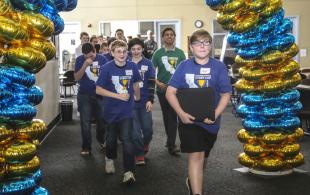Cal Poly’s California Cybersecurity Institute Hosts 400 Middle School and High School Students at Virtual California Cyber Innovation Challenge
Two Southern California high schools were top finishers among nearly 80 teams from throughout the state
SAN LUIS OBISPO — Two teams from Southern California high schools earned top honors at the fourth annual California Cyber Innovation Challenge — the cybersecurity championship for the Golden State — that was hosted earlier in October by Cal Poly’s California Cybersecurity Institute (CCI).
The 2020 challenge was a California-focused cybersecurity competition that attracted more than 400 high school and middle school students from throughout the state who competed in two divisions at the three-day, virtual event held Oct. 2-4.
The competition focused on navigating an immersive, 3D experience for challenge participants. It featured a live-immersive environment at Cal Poly’s digital range, located east of campus at Camp San Luis Obispo. Nearly 80 student teams responded to a fictional storyline of a hacked satellite falling to Earth. They engaged in multiple hands-on, space-themed set designs to solve the cyber mystery of how the satellite was attacked.
Forty-three teams completed in the Difficult Division. Team Amalthea from North Hollywood High School took first place. It was made up of: Fletcher Boydston; Matthew Chak; Zander Denning; Eric Gediman; Joshua Kave; and Athena Taylor.
CyberAegis Pentaquark from Del Norte High School in San Diego and Amador High School’s Amador 3, from Sutter, were second and third respectively. The Del Norte High runners-up included: Rohan Juneja; Akshay Rohatgi; Tanay Shah; Safin Singh; Ellen Xu; and Alvin Zheng. Third-place Amador 3 was composed of: Ryken Adams-Barnes; Kumel Hasni; Mathew Newman; Mathew Prada; Myles Sloan; and Jessica Traugot.
RAWSUGAR of Mira Costa High School in Manhattan Beach won the 35-team Intermediate Division. It was made up of: Jack Cooperman; Neal Jha; Clark Katsouleas; Cole McCorkendale; and Noah Sedlik.
San Ysidro 1 from San Ysidro High School, a border town area of San Diego, took second; and Cedarlane 1 from Cedarlane Academy, a middle school from Hacienda Heights, was third. The San Ysidro High team included: Adrian Arguelles; Emiliano Lara Ayala; Iker Herrera; Daniel Martinez; and Gabriel Pulido. Cedarlane’s third-place team was composed of: Joshua Chuang; Ivan Kuo; Ethan Luu; Andrew Zhao; and Alan Zhong.
“CCIC is the nexus of space and cyber, and now virtual cyber range and experiential gaming. How can you go wrong?” said Bill Britton, CCI director and Cal Poly’s vice president of Information Technology and chief information officer. “This is exactly how we focus to develop the next generation of space-cyber protectors.”
The event featured welcoming remarks on Oct. 2 from Vint Cerf, one of “the fathers of the internet,” and Jeff Moss, founder of DEF CON, the world’s largest, longest continuously run underground hacking conference, and Black Hat, which has evolved from a single event in Las Vegas, Nevada, to the most respected international information security event series.
The next day, 78 teams of school students began the competition by working on Amazon Web Services 3D Sumerian and Discord platforms to collect evidence and solve the cyber satellite crime. Challenge teams, coaches, event sponsors and event staff communicated via Discord, a voice and text chat app for groups of gamers.
The virtual challenge utilized PCAP files from Wireshark, a program used for analyzing networks. These were created by Laura Chappell, a Wireshark guru and leading cybercrime instructor, to create the immersive virtual locations where teams could collect evidence, perform digital forensics and advance through the competition.
During the challenge, CCIC organizers conducted activities, information booths and cyber-related puzzles that students could participate in via Discord and social media. Once the first phase of the challenge was completed on Oct. 3, the CCIC team selected the top five teams from each division to advance to the next round.
The difference between divisions was the difficulty of the challenge and the amount of assistance teams could receive from the challenge’s Command and Control Center. Intermediate teams could get more help than groups in the Difficult Division.
Those 10 teams on Oct. 4 presented their evidence and solutions to a panel of judges, who evaluated each group’s efforts to solving the cyber-crime. Judges included academics, military and government officials, students, security researchers, cybersecurity professionals, representatives from the U.S. Department of Commerce’s National Institute of Standards and Technology laboratory, private industry and a DEF CON Goon, one of the staff of that annual hacking convention.
For an inside look at the event, check out the videos below or visit https://cci.calpoly.edu/events/ccic/2020/home.
More Online:
- CCIC 2020 Mission Brief: https://youtu.be/BgB1qRLnZN4
- Vint Cerf Q&A: https://youtu.be/ztakqBA2GPY
- Jeff Moss Address: https://youtu.be/QnECgb7LFE8
- Renee Wynn Closing Ceremony Remarks: https://youtu.be/ZNrzMQmbM_k
About the California Cybersecurity Institute
The California Cybersecurity Institute (CCI) is a robust, multi-agency effort to protect California from future cyber threats through training and research for government, academia, military, law enforcement, first responders and private entities. Located in San Luis Obispo, California, the CCI aims to educate the next generation cyber workforce and provide faculty, students, and professionals with hands-on training and resources. Further information about Cal Poly CCI is available online at CCI.CalPoly.edu.
Contact: Makenna Downing
Cal Poly California Cybersecurity Institute
714-333-5034; madownin@calpoly.edu

